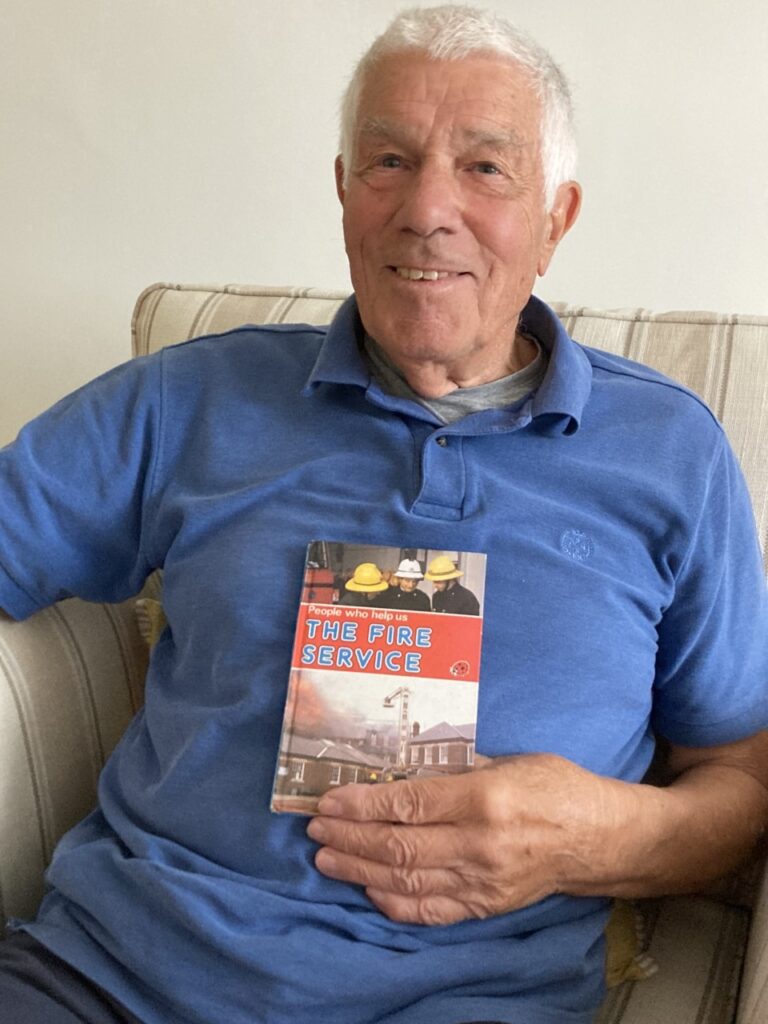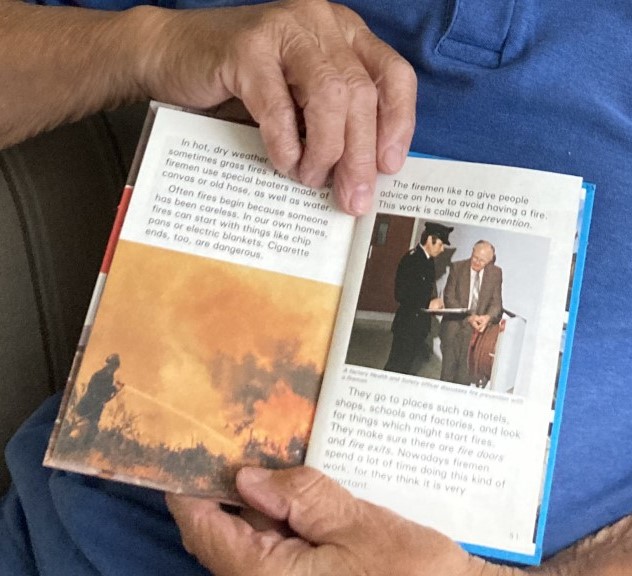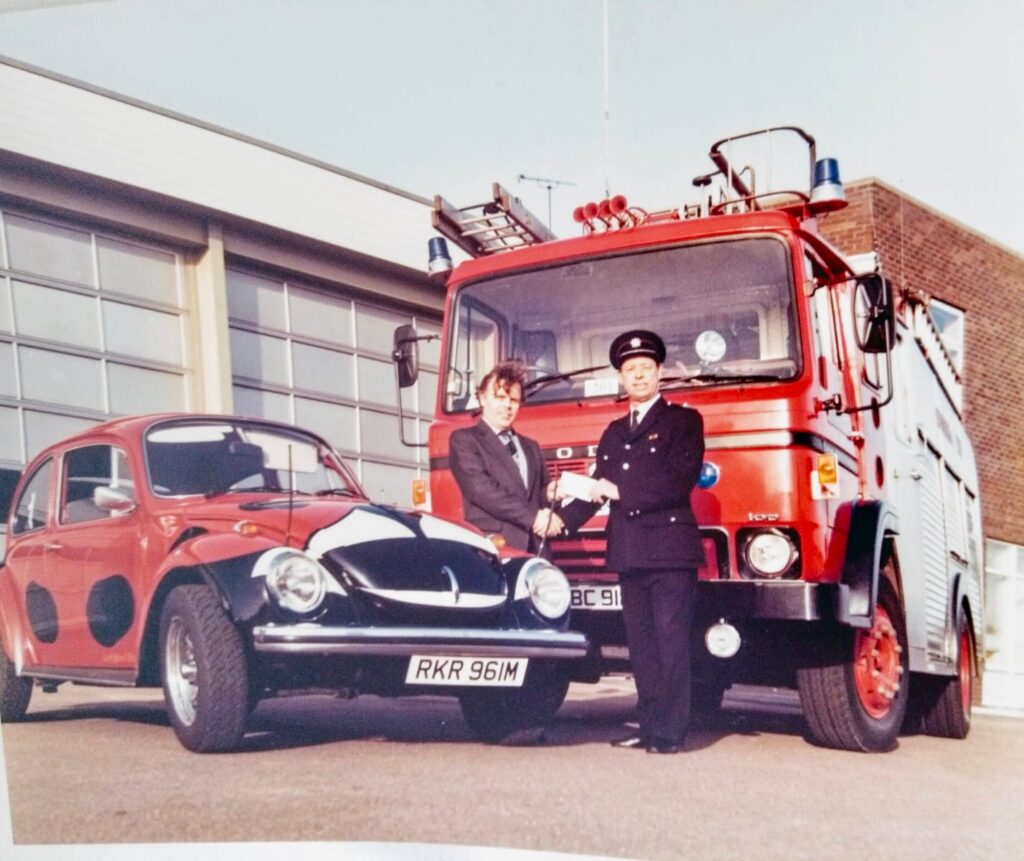The making of Ladybird’s ‘The Fire Service’ book
6 September 2022
A recent discussion about Charnwood Museum’s People at Work exhibition sparked memories for a former Loughborough resident who remembers one of the titles being made.
Jane Wellington’s father, Jim Wellington, was Station Commander at Loughborough Fire Station when the Ladybird Book ‘People who help us – The Fire Service’ was put together. In fact, he was responsible for overseeing the photos illustrating it being taken, and as a result, very nearly missed out on being in the book himself! With many thanks to Jane for collecting Jim and his wife Phyl’s memories of that time.

Jim: Ladybird Books were doing a series on people who help us and they wanted to do the fire service. I think Eddie [Clark] knew someone who worked for Ladybird at the time, so he contacted me and it started from there. Obviously, I had to get permission from Mr Rawlinson, the chief officer, for them to take the pictures.
He told me my brief was to make sure the shots weren’t detrimental to the brigade. After one of the shoots – the only time I wasn’t there – I had to throw a lot of the pictures away and have them retaken because the firemen were incorrectly dressed.
Jane: So your neck was on the line?
Oh god, yeah. And when the final proof came, I realised I wasn’t in it because I was always the wrong side of the camera!
In the book, you’re holding a clipboard and stood with a gentleman, which the caption says is inspecting a factory.
That’s not true at all, it was a simulation. Fire Prevention used to do the inspections, it was follow-up visits the fire brigade used to do. But the photograph was staged for the book.
Because the Fire Prevention officer wasn’t available?
No no, purely so I would be in the book! The manager of Ladybird said ‘but you’re not in it! We can’t have that! Come down [to Ladybird] and we’ll take a picture!’ That was a sprinkler valve, I think, but of course we used to do that sort of stuff, anyway.

Bill Wells was part of Fire Prevention, wasn’t he?
Yes, he was. And John Gibson.
Eddie Clark is on the front page – what was his role?
He was a sub-officer in charge of a watch. There were three watches in those days – red, white and blue, and now they’ve got green as well. A lot of the photographs are Eddie’s watch – blue watch – and some are red watch. I’m not sure there were any white.
And that’s Phil Louis, leading fireman.
He looks like he’s laughing there!
He probably was! And John Bickley is in the middle, and Simon Snorkel on the front.
There’s a picture here of a pump alongside a canal. Can you remember where that was?
I think that was down off Derby Road. But all the pictures were staged. The picture of the woman phoning 999, that was Caroline, a secretary in Fire Prevention, which was attached to our station.
So the photographer never pitched up to a real operation?
No no, because that’s not what they wanted. It was very difficult to commit the time. They came down and said ‘right, we want some photos,’ and they’d spend a morning taking photos. And then they’d come back another day and take more pictures. I suppose it took about three weeks. They’d come and they’d run it in when they were doing nothing else.
Some of the photos, Jim says, were taken at Central Station in Leicester. Hampshire Fire Brigade also provided photographs, as did Jack Stretton, a retired sub-officer who’d returned to the brigade as an electrician.

I have a memory that the yellow helmets were always called daffodils – is that right?
Phyl: No, but the men called the white ones snowdrops.
Because they were rare?
Jim: It was detrimental, really …
Phyl: Not only that, but ‘oh, look, the snow drops have turned out, now they’ll be telling us how to do it!’ And then when you were a snowdrop, you didn’t appreciate that!
Getting back to the book, was it fun to do? Were people happy to be part of it?
Jim: Oh, of course they were, yeah.
So after the book, did anything happen? Was there a launch? Were you given any books?
No, you had to buy one! I ended up buying a couple.
Phyl: I don’t believe they could come and give you books, because how many [would they need] if they’d got to give the whole fire brigade one?
And when was this?
(Phyl reads): First edition – MCMIXXXII – 1982!
Interview recorded by Jane Wellington on Friday 2nd September 2022